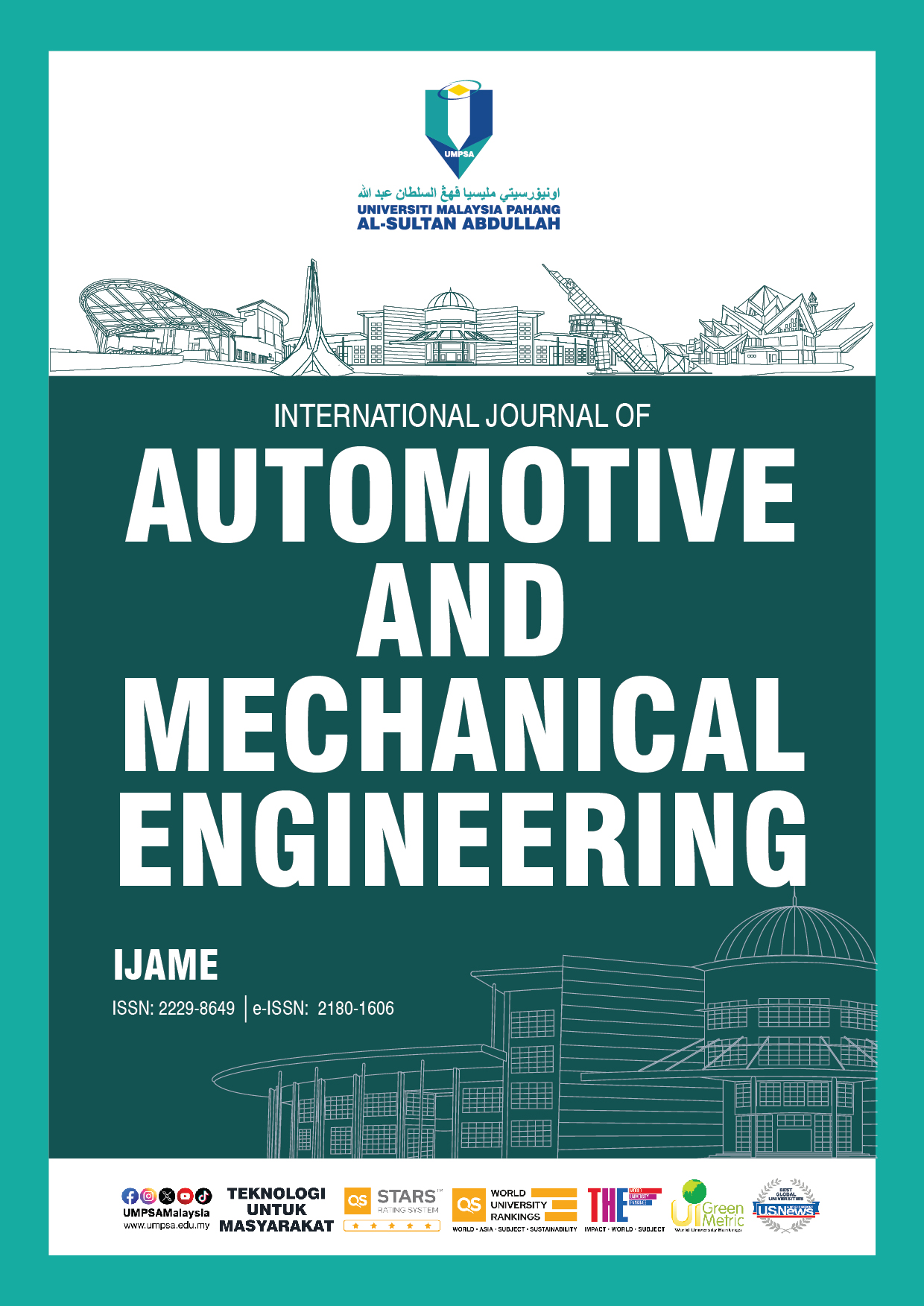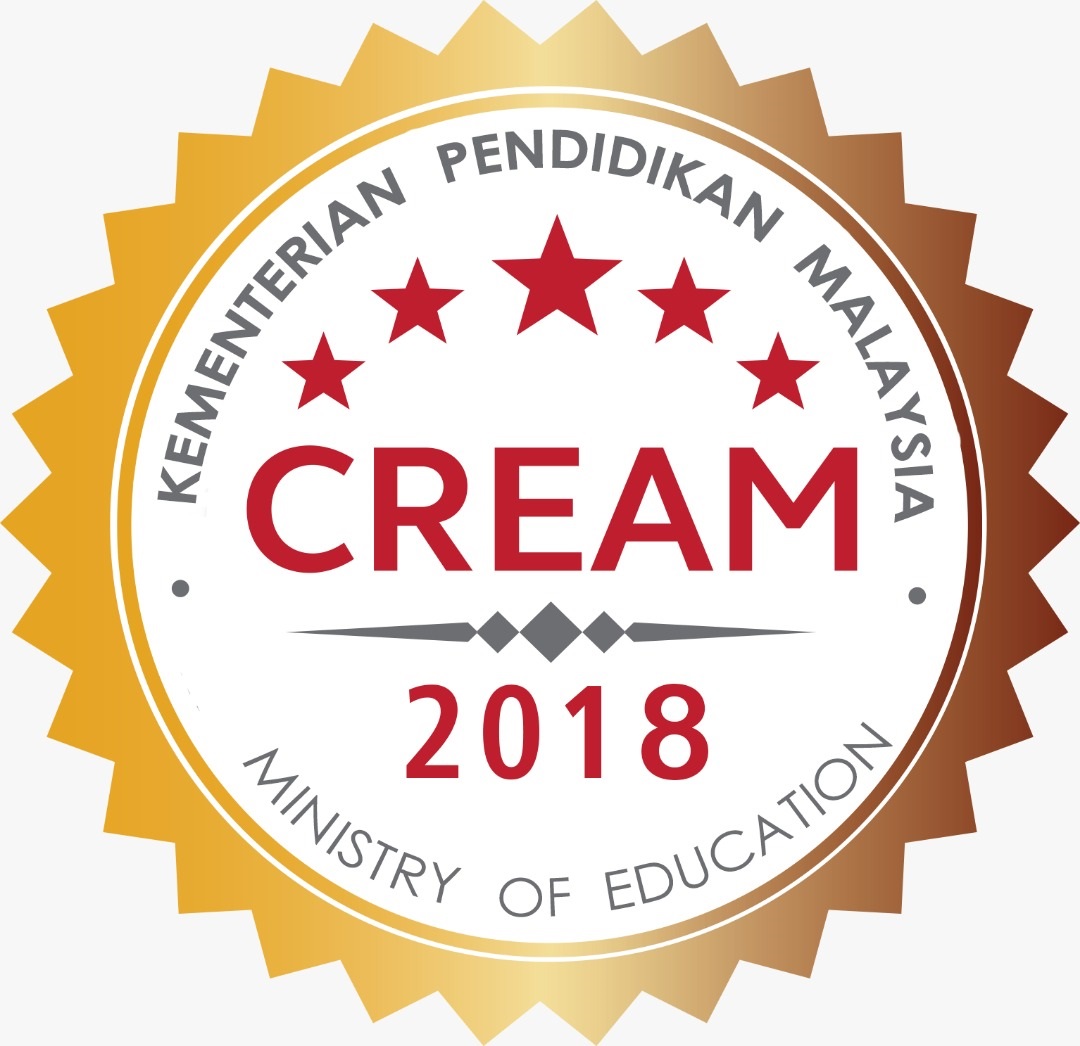Thermal Investigation of Heat Transfer Enhancement in a Rectangular Duct Provided with Different Configurations of Semi-Circular Ribs
DOI:
https://doi.org/10.15282/ijame.22.1.2025.2.0919Keywords:
Reynolds number, Semi-circular rib, Nusselt number, Thermal Performance, Friction factorAbstract
Past research studies have explored the use of continuous ribs (with square or rectangular cross-sections) to improve the thermal efficiency of ducts or channels. Some researchers have also investigated the impact of different rib shapes, such as triangular, semi-circular, trapezoidal, and pentagonal, on thermal performance. However, there has been limited research focusing on how various semi-circular rib patterns influence the thermal behavior of rectangular ducts. This study investigates the effects of different semi-circular rib designs on the thermal efficiency and friction factor of a rectangular duct. Six distinct rib configurations, ranging from continuous to hybrid patterns, were applied to the bottom wall of the test section. The thermo-hydraulic performance (η) of the ribbed ducts was measured and compared to that of plain ducts. Experimental results revealed that the ratio of Nusselt numbers ranged from 1.44 to 2.57. The ratio of the friction factor ranged from 2.20 to 4.51. The thermal enhancement ratios for semi-circular rib designs ranged from 1.08 to 1.69, relative to a plain duct. The hybrid rib configuration surpassed all other rib designs, delivering the most significant improvement in thermal performance. This was primarily due to enhanced flow distribution and reduced thermal resistance. The superior performance of the hybrid ribs resulted from their innovative design, which combines ribs truncated at both ends with ribs truncated at the center, creating a unique hybrid rib arrangement. from the combined rib design. Across the specified range of Reynolds numbers, the hybrid rib duct demonstrated a thermal performance increase of 1.47 to 1.69 times compared to the plain duct.
References
[1] S. Thikane and S. Mashyal, “A comprehensive review and comparative study of various rib configurations used in rectangular duct for heat transfer enhancement,” Asian Review of Mechanical Engineering, vol. 11, no. 1, pp. 33-39, 2022.
[2] S. Thikane and S. Mashyal, “A comprehensive review and comparative study of various rib configurations used in rectangular duct for heat transfer enhancement,” International Journal of Management, Technology and Engineering, vol. 13, no. 11, pp. 1-8, 2023.
[3] S. Thikane and S. Mashyal, “A comprehensive review and comparative study of various rib configurations used in rectangular duct for heat transfer enhancement,” International Journal of Innovative Research in Technology, vol. 09, no. 05, pp. 238-245, 2022.
[4] R. Karwa, S. Solanki, and J. Saini, “Thermo-hydraulic performance of solar air heaters having integral chamfered rib roughness on absorber plates,” Energy, vol. 26, pp. 161-176, 2001.
[5] M. Sahu and J. Bhagoria, “Augmentation of heat transfer coefficient by using 90° broken transverse ribs on absorber plate of solar air heater,” Renewable Energy, vol. 30, pp. 2057-2073, 2005.
[6] S. Alfarawi, S. Abdel-Moneim and A. Bodalal, “Experimental investigations of heat transfer enhancement from rectangular duct roughened by hybrid ribs,” International Journal of Thermal Sciences, vol.118, pp. 123-138, 2017.
[7] S. Kore, S. Dingare, S. Chinchanikar, P. Hujare, and A. Mache, “Experimental Analysis of different shaped ribs on heat transfer and fluid flow characteristics,” E3S Web of Conferences, vol. 170, pp. 01-19, 2020.
[8] J. Park, J. Han, Y. Huang and S. Ou, “Heat transfer performance comparisons of five different rectangular channels with parallel angled ribs,” International Journal of Heat Mass Transfer, vol. 35, pp. 2891-2903, 1992.
[9] J. Liu, J. Gao, T. Gao, and X. Shi, “Heat transfer characteristics in steam-cooled rectangular channels with two opposite rib-roughened walls,” Applied Thermal Engineering, vol. 50, pp. 104-111, 2013.
[10] N. Deo, S. Chander and J. Saini, “Performance analysis of solar air heater duct roughened with multi-gap V-down ribs combined with staggered ribs,” Renewable Energy, vol. 91, pp. 484-500, 2016.
[11] R. Karwa, “Experimental studies of augmented heat transfer and friction in asymmetrically heated rectangular ducts with ribs on the heated wall in transverse, inclined, V-continuous and V-discrete pattern,” International Communications in Heat Mass Transfer, vol. 30, no. 2, pp. 241-250, 2003.
[12] E. Momin, J. Saini and S. Solanki, “Heat transfer and friction in solar air heater duct with V-shaped rib roughness on absorber plate,” International Journal of Heat Mass Transfer, vol. 45, pp. 3383-3396, 2002.
[13] S. Singh, S. Chander and J. Saini, “Heat transfer and friction factor correlations of solar air heater ducts artificially roughened with discrete V-down ribs,” Energy, vol. 36, no. 8, pp. 5053-5064, 2011.
[14] S. Singh, S. Chander and J. Saini, “Thermo-hydraulic performance due to relative roughness pitch in V-down rib with gap in solar air heater duct-comparison with similar rib roughness geometries,” Renewable and Sustainable Energy Reviews, vol. 43, pp. 1159-1166, 2015.
[15] N. Sharma, A. Tariq and M. Mishra, “Detailed heat transfer and fluid flow investigation in a rectangular duct with truncated prismatic rib,” Experimental Thermal and Fluid Science, vol. 96, pp. 383-396, 2018.
[16] N. Sharma, A. Tariq, and M. Sharma, “Experimental investigation of heat transfer enhancement in rectangular duct with pentagonal ribs,” Heat Transfer Engineering, vol. 40, pp. 147-165, 2019.
[17] N. Fifi, A. Abdala, and Q. Zheng, “Effects of curved ribs on heat transfer, friction and exergy loss in rectangular cooling channels by CFD,” Iranian Journal of Science and Technology: Transactions of Mechanical Engineering, vol. 45, pp. 1045-1056, 2021.
[18] H. Ali and A. Munther, “Numerical investigation on heat transfer enhancement and turbulent flow characteristics in a high aspect ratio rectangular duct roughened by intersecting ribs with inclined ribs,” Journal of Engineering, vol. 26, pp. 20-37, 2020.
[19] S. Zahran, A. Sultan, M. Bekheit and M. Elmarghany, “Heat transfer augmentation through rectangular cross section duct with one corrugated surface: An experimental and numerical study,” Case Studies in Thermal Engineering, vol. 36, pp. 1-14, 2022.
[20] S. Thikane and S. Mashyal, “Experimental investigation of effect of different configurations of semi-circular or half-round ribs on heat transfer enhancement in a rectangular duct,” Mechanics Based Design of Structures and Machines, vol. 52, no. 12, pp. 10646-10662, 2024.
[21] S. Thikane and S. Mashyal, “Experimental investigation of effect of different configurations of semicircular or half round ribs on heat transfer enhancement in a rectangular duct,” 2023 IEEE Engineering Informatics, Melbourne, Australia, pp. 1-6, 2023.
[22] A. S. Yadav and A. Gattani, “Revisiting the influence of artificial roughness shapes on heat transfer enhancement,” Materials Today: Proceedings, vol. 62, pp. 1383-1391, 2022.
[23] A. S. Yadav and A. Gattani, “Solar thermal air heater for sustainable development,” Materials Today: Proceedings, vol. 62, pp. 80-86, 2022
[24] A. S. Yadav, A. Agrawal, A. Sharma, and A. Gupta, “Revisiting the effect of ribs on performance of solar air heater using CFD approach,” Materials Today: Proceedings, vol. 63, pp. 240-252, 2022.
[25] A. S. Yadav, A. Agrawal, A. Sharma, S. Sharma, R. Maithani, and A. Kumar, “Augmented artificially roughened solar air heaters,” Materials Today: Proceedings, vol. 63, pp. 226-239, 2022.
[26] A. S. Yadav, A. Mishra, K. Dwivedi, A. Agrawal, A. Galphat, and N. Sharma, “Investigation on performance enhancement due to rib roughened solar air heater,” Materials Today: Proceedings, vol. 63, pp. 726-730, 2022.
[27] A. S. Yadav and A. Sharma, “Experimental investigation on heat transfer enhancement of artificially roughened solar air heater,” Heat Transfer Engineering, vol. 44, pp. 624-637, 2022.
[28] H. Singh, T. Alam, M. Haque Siddiqui, M. Ashraf Ali, and D. Sagar, “Experimental Investigation of Heat Transfer Augmentation Due to Obstacles Mounted in Solar Air Heater Duct,” Experimental Heat Transfer, vol. 37, pp. 162-181, 2022.
[29] A. Kumar and A. Layek, “Nusselt number and friction factor correlation of solar air heater having winglet type vortex generator over absorber plate,” Solar Energy, vol. 205, pp. 334-348, 2020.
[30] S. Zahran, A. Sultan, M. Bekheit, and M. Elmarghany, “Heat transfer augmentation through rectangular cross section duct with one corrugated surface: an experimental and numerical study,” Case Studies in Thermal Engineering, vol. 36, pp. 1-14, 2022.
[31] A. S. Yadav, O. Shukla, A. Sharma, and I. A. Khan, “CFD analysis of heat transfer performance of ribbed solar air heater,” Materials Today: Proceedings, vol. 62, pp. 1413-1419, 2022.
[32] A. S. Yadav, T. Alam, G. Gupta, R. Saxena, N. Gupta, K. Allamraju, et al., “A numerical investigation of an artificially roughened solar air heater,” Energies, vol. 15, pp. 1-27, 2022.
[33] S. Abdel-Moneim, E. Atwan and A. El-Shamy, “Heat transfer and flow friction in a rectangular duct with repeated multiple V-ribs mounted on the bottom wall,” Mansora, Egypt. In: Proceedings of the 12th Int. Mechanical Power Engineering Conference (IMPEC12), vol. 2, pp. 11-25, 2001.
[34] S. Kline, and A. McClintock, “Describing uncertainties in single sample experiments,” Mechanical Engineering, vol. 75, pp. 3-8, 1953.
Downloads
Published
Issue
Section
License
Copyright (c) 2025 The Author(s)

This work is licensed under a Creative Commons Attribution-NonCommercial 4.0 International License.







